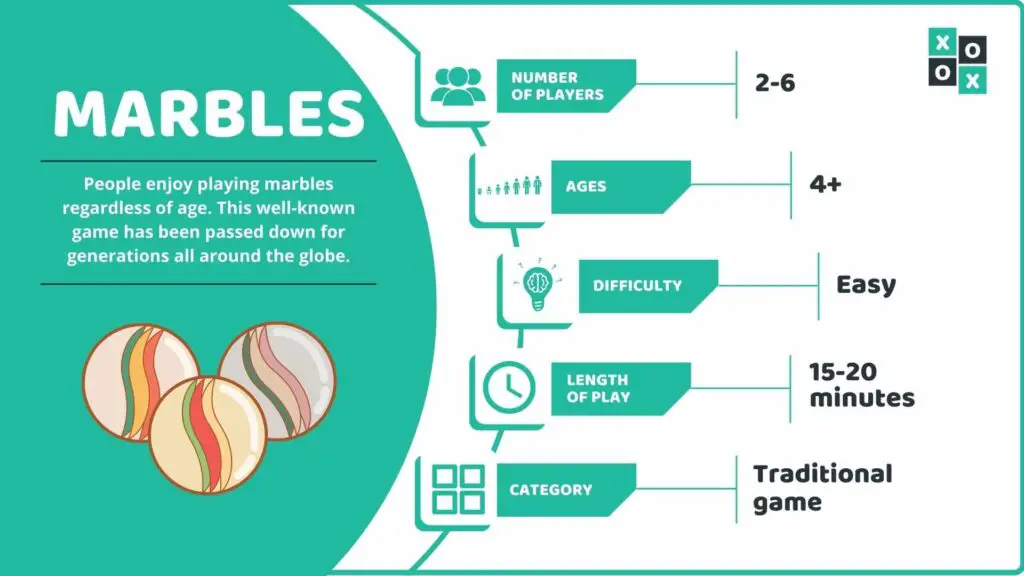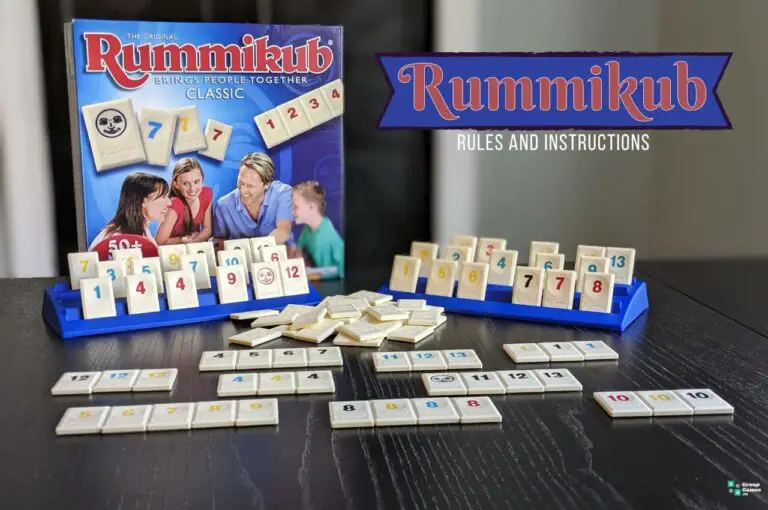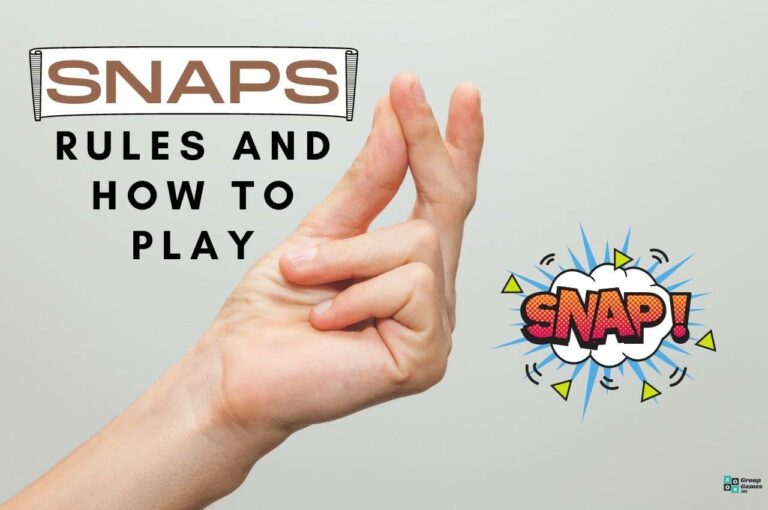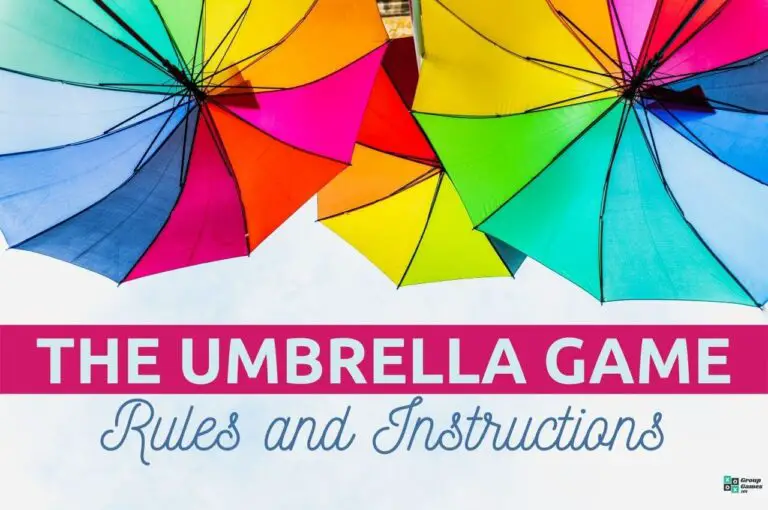Imagine the earliest humans to ever walk the globe playing with rocks and rolled balls of clay inside their cave. Marbles is quite possibly one of the oldest games known to humankind. Read on to discover Marbles rules and gameplay instructions.
These decorative glass balls called marbles are the foundation of a classic childhood game, and over time games involving marbles have truly evolved! For the last 100 years in America, since 1922, people have even competed in a National Marble Tournament.
This Marbles rules guide will cover the following:
- What are Marbles?
- A brief history of Marbles
- What you’ll need to play Marbles
- Marbles Rules
- How to play Marbles (Video Tutorial)
- FAQs
Read on to learn how to play Marbles.
What are Marbles?

Marbles are small glass balls used for playing this traditional childhood game. Nowadays, you’ll find other games and uses for marbles, including DIY craft projects such as jewelry and decor.
Number of Players: 2-6 players
Ages: 4+ (choking hazard for children 3 and under.)
Difficulty: Easy
Length of Play: 15-20 minutes
Category: Traditional games
Similar to: Jacks Game Rules, Pick Up Sticks Rules, Offical Domino Rules
Main Objective: Players try to knock the most marbles outside of a designated circular area to earn the most points.
Why We Love It: People enjoy playing marbles regardless of age. This well-known game has been passed down for generations all around the globe.
A Brief History of Marbles
Historians believe that Marbles is one of the earliest forms of games because cavemen could use rocks or balls of clay to play with.
The development of the beautifully colored marbles we use today has evolved over the years internationally.
In England, the first book on Marbles was published in 1815, stating that glass marbles were first developed by a glassmaker in Germany. Later, the Japanese injected colored glass into marbles for the cat-eye design.
Since 1922, over 100 years ago, an annual Marbles Tournament is held in the United States.
What You’ll Need to Play Marbles
You can purchase marbles in this boxed set.
The complete game box contains:
- 48 playing marbles (glass)
- 2 shooter marbles (glass)
You’ll also need:
- Chalk, tape, or string.
Area of Play
Locate a flat playing surface; usually, a hard floor surface such as a sidewalk or driveway works well, and use string, tape, or chalk to mark out a large circle.
The circle will be your playing area and must be anywhere from 3-10 feet in diameter. If you are a beginner, consider making your circle smaller. When you are ready for a challenge, increase the size of your circle.
A piece of string or yarn cut around 9.5’ long will make a circle of about 3’. This option is great for playing inside.
Next, draw or mark two straight lines on two opposite sides of the circle parallel to one another.
Take out 13 standard marbles to begin playing. Each player needs a large marble called a shooter.
Lagging
To determine which player will go first, both players take a marble and sit behind one straight line.
Taking turns, each player will roll their marble towards the line across the circle. This act is called lagging, and the player whose marble gets the closest to the line without crossing it gets to play first. The player with the next closest marble will play second, and so on.
Set-Up
Arrange the marbles evenly spaced in the shape of a plus sign on the floor in the center of your circle.
If you prefer, another set-up option allows you to scatter the marbles randomly inside the circle instead of placing them in the plus sign formation.
Marbles Rules
To begin, the first player knees down near the circle.
Taking your shooter between your thumb and forefinger, place the palm of your hand up, with at least one knuckle touching the ground.
Now, shoot your large marble towards the others. The objective is to knock at least one of the marbles outside of the circle while keeping your large shooter marble within the circle.
Tip: It may be easier to shoot by aiming at a specific marble instead of simply looking at your shooter.
Earning Points
If you shoot any marbles outside of the circle, you may collect them for one point each.
At this time, the player can shoot again using the shooter in the place where it landed the previous roll.
When you are unable to knock a marble out of the circle, your turn ends, and the next player takes their turn.
Each player begins their first turn by positioning their shooter anywhere they would like to inside the circle.
When your turn ends, leave your shooter where it is positioned inside the circle until your next turn.
If a player knocks your shooter out of the circle, it must remain where it is until your next turn.
This tactic can be deliberate, making it more difficult for your opponent as they will now have to shoot from outside the circle on their next turn.
How to Keep Score in Marbles
In this traditional game of marbles, each player keeps the marbles they knock out of the circle during the game. Each marble collected counts for one point.
The game ends when all the marbles have been knocked out of the circle.
The player at the end of the game with the most points, or most collected marbles, wins!
How to Play Marbles – Video Tutorial
Frequently Asked Questions
How does the marble game work?
Players take turns trying to shoot marbles out of a designated area. When marbles are knocked outside the circle, they are collected and counted for a single point. When all the marbles have been knocked out of the circle, the player with the most points wins the game.
How do you play marbles odd or even?
This marbles guessing game requires at least two players. The first player places a number of marbles in their closed fists. The second player must guess if there is an odd or even number of marbles inside their hands. This is also a fun way to decide which player should go first.
What are the big marbles called?
The large marbles are called shooters. Each player needs their own shooter to shoot the marbles on their turn.
Other Games Similar to Marbles (Our Guides)
If you love playing Marbles, be sure to try out these other iconic childhood games:








